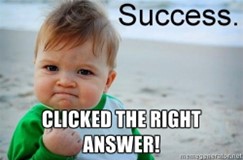Using Humour to Improve Your Learning Content
Shauna Carson
Let's face it, some eLearning content can't be jazzed up with humour. It can't be made more engaging with an avatar, nor can it be enhanced with fast-paced narration and sound effects. Sometimes, eLearning is just very dry and boring because of the content or, in some cases, because of the intended audience (think of an online course for morticians on applying facial makeup to the deceased).
But, for most online learning, adding a bit of humour here and there may just be the difference between building a good course and creating a great course! Here are some things to consider.
1. Is the humour appropriate...
for the audience?
I've seen a few presentations that have used a cartoon as an icebreaker or as a way of introducing a topic. Dilbert, for instance, seems to be popular with some eLearning developers. The strip by Scott Adams features an engineer named Dilbert and pokes fun at corporate culture. But, as an instructional designer whose learning audience often lives in a corporate culture, I have to question the appropriateness of using the strip in corporate eLearning (and Dilbert is one of my favourite comic strips). Many management-types do not like Dilbert and I shy away from using it because management pays my fees.
If you are going to use cartoons to make a point, get suggestions from your client or have your graphic art department draw one. You can use memes like the one I used at the beginning of this article or purchase your favourite strip for use in your content. Just remember to respect the author's copyright and pay for the use and cite your source.
for the age group?
Age appropriateness is another consideration. You might think it funny to include a Monty Python clip about arguments in your effective communication course for management trainees, but will the intended audience appreciate the humour? Your audience might possibly be people who are in their early twenties and most likely remember John Cleese and company as, "That weird English show that my dad used to like". You may as well be making jokes about a wringer washer!
You are probably better off writing your own material about miscommunication in a context that they will understand, for example, a cat meme with a confusing message or a typo in a text message followed by the wrong emoji (I have no idea what that would look like, but my daughter thinks it would be a hilarious example of communication gone wrong).
for the age in which we live?
Today's working world is not the one your grandparents or your parents inhabited. Tolerance and acceptance of all are key principles in today's workplace, making many of the old stories and jokes unacceptable (they were unacceptable anyway, but now it's official). You can't describe a workplace issue with, "So, this (insert any stereotype here) loads the paper into the shredder and asks, "Why isn't it printing?". You could use the example, but you would have to say that the person was "a new employee who had not yet received proper instruction on reloading the unit's printer", which really isn't funny at all.
Be sure that the humour you use is not offensive to anyone; it's just that simple.
2. Is the humour easily understood?
Nobody thinks that a joke you have to explain is funny. You might think that "The Centipede's Dilemma" is a great way to introduce how humans often do things without thinking about them, but many will not understand your point. This may be especially important if your audience consists of English-as-a-second-language speakers. You need common references that everyone can understand for your jokes to work.
Another thing to consider when using humour in online learning is that the learner may not be able to tell when you are trying to be funny. Obscure references such as the one I just used can confuse learners or, worse, make them unhappy; unhappy learners mean an unhappy client -- and that's just not funny!
3. Is the humour relevant to the workplace?
Twenty-three years of creating workplace learning content has taken me to many different workplaces, including corporate towers, strip mall offices, call centres, a steel spring manufacturing plant, a strand-board mill, a petroleum tank farm and, most memorably, a beef processing plant. What I learned from those experiences is that I know nothing about the jobs that people do there or what working in those places is like. I relied on subject matter experts and the people I interviewed to tell me what they did, how they did it and what their workplace was like.
Never assume that a story you have about work will go over with your audience. Instead, talk to the people who work there. Find out what goes on. Let them share their stories with you. When you're talking to them, ask for examples of what can go wrong and of how things are when everything is going as it should. Then, you can use your imagination to create a humorous scenario that training can solve. If you get it right, your SMEs will let you know. If you get it wrong, they'll help you fix it to make it believable and relevant to the workplace.
Enhancing Learning Content with Humour
After all that, you may be wondering, "What CAN I do to enhance learning content with humour?". Here are a few suggestions.
Memes
A meme is a photo, picture or video that transmits a cultural symbol or idea. They are often humorous, and it seems that you can find a meme on almost any topic. I searched for a random example by using "forklift training meme" as a search string and found all sorts of funny ones such as the below, which could be used as the final screen in an online course.

souce: quick meme
You can also use memes to promote eLearning or provide feedback for learning activities.

source: meme generator
For more on memes and their usage, read Paul Gill's article, "What is a Meme?".
Video
Video is one of the "must have" components of eLearning, so why not use a funny video to make a point? If you have the talent and the budget, you can create your own video, you can parody a well-known video, or you may be able to find an appropriate one online.
Check out Official Comedy's YouTube video on working with millennials or this training video parody on creating a training video for some inspiration.
Games
Gamification is another way to introduce humour in eLearning. Create a funny game where the rewards and the consequences make the learners laugh. For example, you could reward learners with a nice slice of pie each time they successfully complete a task and when all tasks are completed, they wind up with a lovely pie. But, if they are not successful, you could hit them with a pie in the face by splattering a virtual pie all over their screen. Again, you are only limited by your imagination and your budget.
Avatars
An avatar is an animated character that you can use to present your eLearning content. You can use the character to introduce topics and provide segues from one screen to the next. An avatar can also be a source of humour. Slip an aside into the narration now and then, such as "If you thought that was exciting, click NEXT and let the thrill ride continue" to spark things up. Be careful not to let the avatar steal the show.
Sound effects
"Zap!" "Bang!" "Peowwwww!" "Vvvvvvvvvvttt!"
Think about the cartoons you loved when you were a kid. One of the things that made them funny was the sound effects. They emphasized the joke and were an integral part of the humour. So, why not use them in eLearning? I'm not saying that every screen needs an effect, but you might want to consider using them in the feedback you give learners when they complete activities. A quick round of applause or fireworks complete with sound would add some entertainment to the usual "You have successfully completed the activity" message.
Conclusion
Well, that may not have been the laugh riot you thought it was going to be, but that's my take on using humour in eLearning content.
Humour is a valuable tool and can make content more engaging. The true test of its effectiveness is measured in learner satisfaction and successful completion of the course. Remember though, your course could be a laugh-a-minute feature and be the funniest thing since grandpa stubbed his toe and lost his dentures, but if nothing is learned, the course is a failure.
Use humour wisely and sparingly. Use it when appropriate and where the client likes it. As we all know, having a storyboard come back marked up with deletions is just not funny.
And so, let me just say...
📘 Ready to Elevate Your Learning Strategy?
Explore our comprehensive library of eBooks and tools on learning resource development, competency-based learning, and LMS implementation. Transform your training programs with insights from industry experts and practical templates.
Shauna Carson
Shauna graduated from the University of Toronto in 2002 with a Master of Arts in English before moving home to Calgary to work in the fast-paced, detail-oriented oil and gas industry. Now certified as a technical writer, Shauna is comfortable writing in a variety of styles, and for a variety of audiences.
